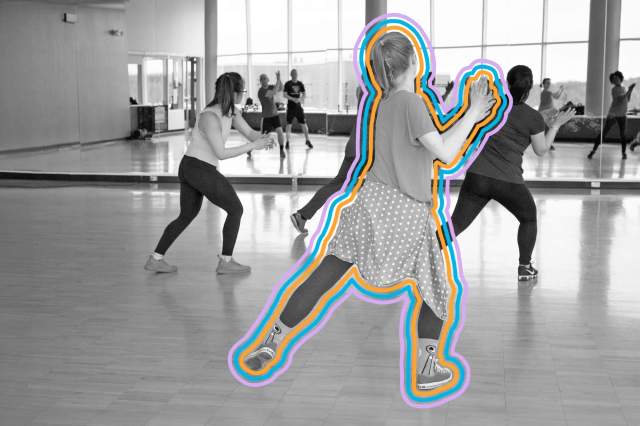
Humans Have Danced for Tens of Thousands of Years
The earliest book about dance is around 1,500 years old, and the first written records of dancing date back about 4,000 years, to ancient Egypt — but cave paintings and rock art more than 20,000 years old show that dance far predates written communication. It’s possible that we’ve been dancing since before we were human, since chimpanzees can keep a beat, too.

The Foxtrot Was One of Several Animal Dances
The ragtime era (circa 1899 to 1917) brought with it many then-scandalous dances that are pretty standard ballroom fare today, such as the foxtrot. But in its heyday, the foxtrot was just one of a number of animal-themed dances that had people clutching their pearls. The turkey trot came before the foxtrot, and was so feared by the morality police of the day that the New York Times reported that Woodrow Wilson canceled his inaugural ball over it and other animal dances. (Wilson denied the claim.) The grizzly bear, featuring two dancers that come together in a kind of frozen bear hug, also raised hackles. Other examples include the bunny hug, the kangaroo dip, and the sloth squeeze.

Break Dancing Was Briefly an Olympic Sport
Breaking, or break dancing, emerged from New York’s hip-hop culture in the 1970s, named for the break, a musical technique used by DJs. By the 1980s, it had hit the mainstream. The form is improvisational and acrobatic, requiring both a sense of rhythm and a high level of athleticism.
The first Olympic event to feature breaking was the Summer Youth Olympic Games in Buenos Aires in 2018, and it debuted as part of the main event during the 2024 Summer Olympics in Paris. However, the IOC announced after the Games that it would not return in 2028.
More Interesting Reads

Dancing Could Help Treat Parkinson’s
Dancing is great for your brain, and it could even be therapeutic for those with degenerative neurological disorders like Parkinson’s disease. Parkinson’s comes with a lot of dysfunction in the motor system, like slowed movement, stiffness, tremors, and loss of balance. Rhythmic auditory stimulation, a therapy that has patients move to a rhythm — like dance — appears to help significantly with gait and motor function. This helps decrease fall risk and improve quality of life. Similar treatments have also been studied for Huntington’s disease, although their efficacy is still up in the air.

Early Ballet Dancers Were Mostly Male
Ballet has a reputation as a feminine art, and modern choreography often showcases ballerinas at the expense of ballerinos. But for the first century-plus of the art, which developed in Europe (particularly France) in the 15th and 16th centuries, men were considered the primary performers. The first professional ballerina didn’t even come along until the 17th century, and women didn’t become stars until after the French Revolution in the late 18th century. Male dancers took the brunt of the hatred that had been directed at the aristocracy, while female dancers were able to carry the traditionally aristocratic art form into a more populist era.

The Longest Conga Line Was 119,986 People Long
Conga is a spontaneous Cuban dance in which a solo dancer or a group casually meanders around a street or a dance floor. You may have ended up in a conga line at a wedding or similar large gathering — one person puts their hands on another person’s shoulders, and the next thing you know you have a whole connected parade of dancers.
The longest conga line ever recorded was formed in Miami during the Cuban street festival Calle Ocho on March 13, 1988. A whopping 119,986 people lined up to set the record. The festival followed up that record with another one in 2012, this time featuring the world’s largest flag. (The festival has also set records for largest piñata, largest cigar, and most domino players.)

Dance Marathons Could Get Dangerous
Multiple jurisdictions in the United States, including New York, Boston, Los Angeles, and Seattle, have had rules on the books banning dance marathons, an old-timey fundraising competition that rose to prominence in the 1920s and during the Great Depression. No, it’s not because of the turkey trot — it’s because of far more legitimate dangers like dehydration, overexertion, and worse.
Not all the laws are on the books anymore — Seattle, for example, axed theirs along with a bunch of other antiquated laws in the 1970s — but dance marathons are far less prevalent and, when they do take place, more precautions tend to be put in place. The Guinness Book of World Records, for example, only supervises dance marathons that offer at least five minutes of rest for every hour of continuous dancing, which can accumulate if not taken, and records can only be set by people ages 16 and over. The current solo record-holder is Indian 16-year-old Srushti Sudhir Jagtap, who danced for 127 hours in 2023.

You Have To Call the Police To Dance in Public in Sweden
Sweden put a law on the books in 1956 that required permits for any public dancing, so if you wanted to cut a rug at a bar, the owner would need government approval first. If the authorities came by and observed dancing without a permit, the establishment could lose their liquor and business licenses.
The requirement was finally lifted in 2023, but it’s still not exactly a free-for-all. If there’s about to be dancing, you still have to call the police to give them a heads up.












